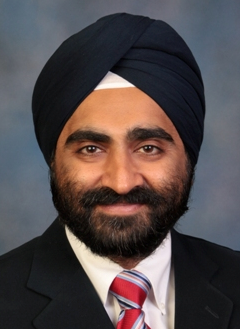#SCM16: Potassium and Cardiac Events in ESRD
 Dr. Bhupinder Singh (BS), from ZS Pharma in San Mateo, California, discusses his abstract for the National Kidney Foundation’s 2016 Spring Clinical Meetings (SCM16), Multicenter, Prospective, Observational Study Assessing Potassium and Cardiac Rhythm Trends in ESRD Subjects on Maintenance Hemodialysis, with Dr. Kenar Jhaveri, AJKD Blog Editor.
Dr. Bhupinder Singh (BS), from ZS Pharma in San Mateo, California, discusses his abstract for the National Kidney Foundation’s 2016 Spring Clinical Meetings (SCM16), Multicenter, Prospective, Observational Study Assessing Potassium and Cardiac Rhythm Trends in ESRD Subjects on Maintenance Hemodialysis, with Dr. Kenar Jhaveri, AJKD Blog Editor.
AJKDblog: Why don’t you tell us a little about your research and abstract being presented at the NKF 2016 Spring Meetings?
BS: We are conducting a multicenter, prospective, observational study to assess serum potassium (K) and cardiac rhythm trends in patients on maintenance hemodialysis. Approximately 240 patients across 18 sites will be enrolled in the study. We hope to finish enrollment by May 31, 2016.
Patients in the study are followed for 12 days, during which time they have frequent blood draws on dialysis and non-dialysis days as well as undergo continuous cardiac rhythm monitoring with a wearable device. The primary endpoint of the study is the incidence of predialysis hyperkalemia during the long interdialytic intervals among patients who are on dialysis. A number of secondary endpoints are being examined, including delta changes in K (delta K) during dialysis as well as incidence of cardiac arrhythmias during the observational period.
Another exciting area we are exploring as part of this study is the correlation of serum K levels with signal-averaged, processed electrocardiogram (EKG). If validated, this could allow serum K determination via EKG analysis, and form the basis for bloodless, remote K monitoring in the future. This is being done in collaboration with Drs. Paul Friedman and John Dillon from the Mayo Clinic in Rochester, Minnesota.
AJKDblog: What other parameters are you going to be monitoring in the dialysis prescription?
BS: We are specifically looking at dialysate K level and how that correlates with intradialytic serum delta K. Along with potassium, we are collecting information on changes in magnesium, phosphorus, calcium, and bicarbonate.
AJKDblog: Where do you and your group go from here?
BS: Once we understand “K physiology” in this patient population, we can plan interventional studies.
I also want to take this opportunity to thank all the investigators, research staff, and patients who are participating in this intense study.
—
Check out more AJKDblog coverage of the NKF’s 2016 Spring Clinical Meetings (#SCM16)!

Leave a Reply